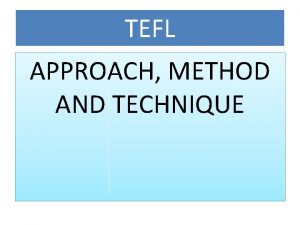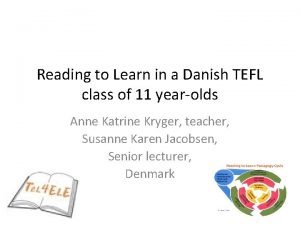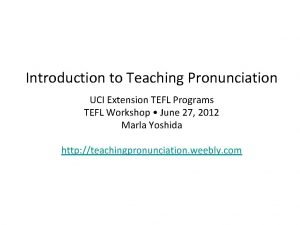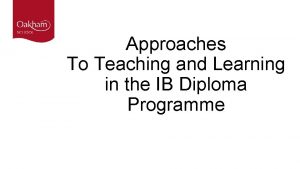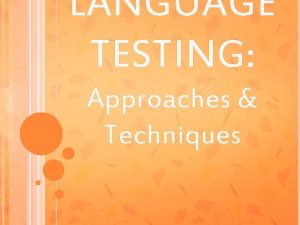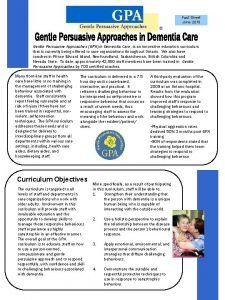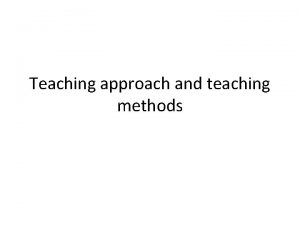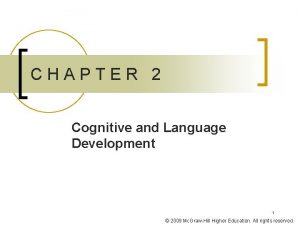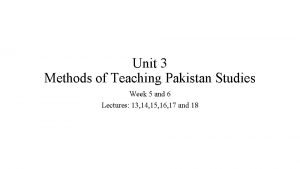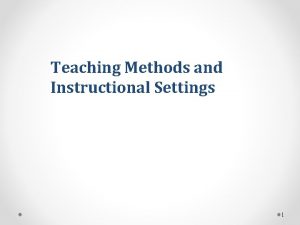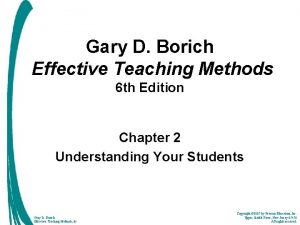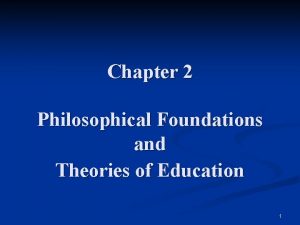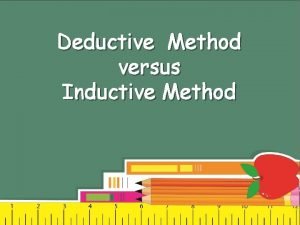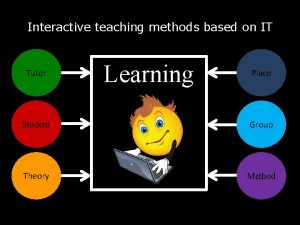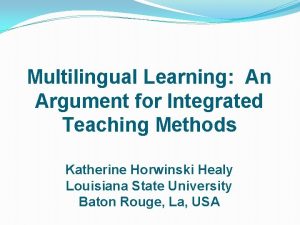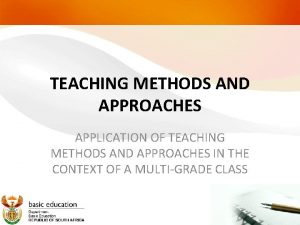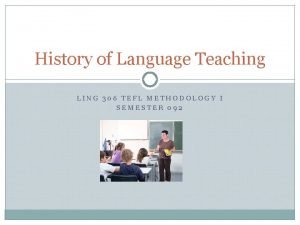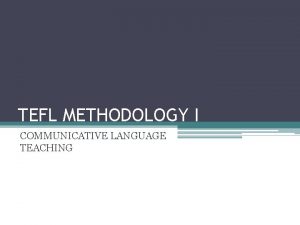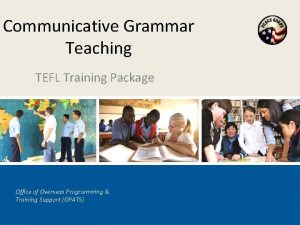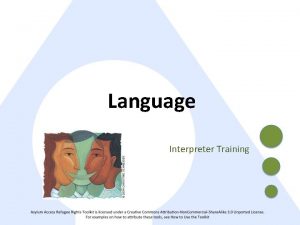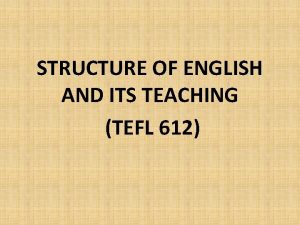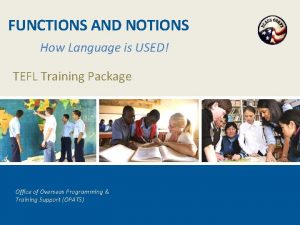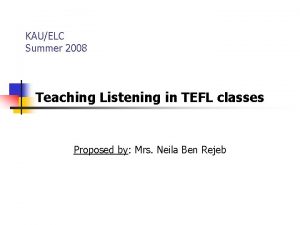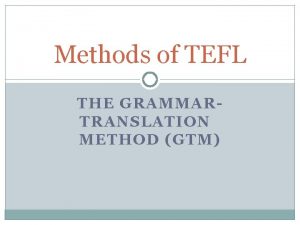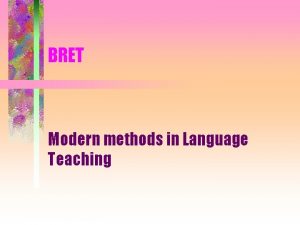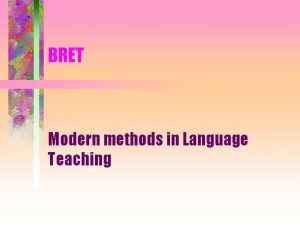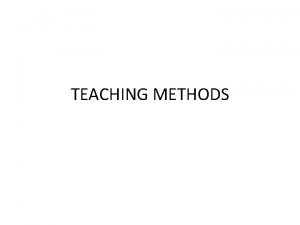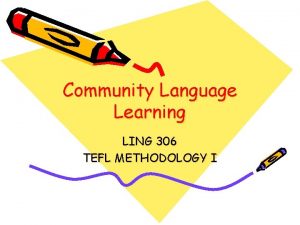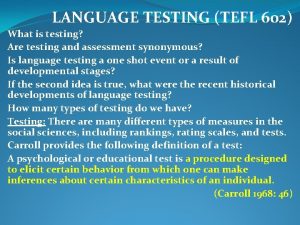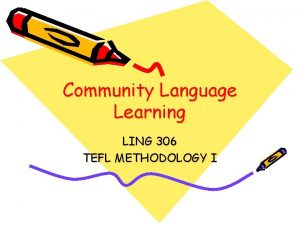Approaches and Methods in Language Teaching TEFL Training























- Slides: 23

Approaches and Methods in Language Teaching TEFL Training Package Office of Overseas Programming & Training Support (OPATS)

What do you know…? List and briefly describe any language teaching approaches and methods that you know. Why should we consider multiple methods and approaches to teaching language?

Language Teaching Approaches & Methods § § § § Grammar Translation (G/T) Audio-Lingual Method (ALM) Direct Approach Suggestopedia The Natural Way Community Language Learning The Silent Way Cognitive Academic Language Learning Approach Total Physical Response (TPR) Jazz Chants Language Experience Approach (LEA) Neurolinguistic Programming The COMMUNICATIVE APPROACH (in another session)

Today’s Focus: Approaches • Grammar Translation (G/T) • Audio-Lingual Method (ALM) • Direct Approach Methods • Total Physical Response (TPR) • Jazz Chants • Language Experience Approach (LEA)

1. Grammar Translation Method § Oldest language teaching method § Communicating in a language was less important in the past when there was less mobility § Language learning was erudition (learnedness), to show one’s membership in an academic community § Main languages taught for a long time: classical Greek & Latin— dead languages no one used for communication § Learning is primarily text-based, not verbal

Grammar Translation (G/T) TECHNIQUES § Learn and practice grammar rules § Memorize vocabulary § Engage in translation § Learn culture with a capital “C” (like literature) § Teacher centered approach (teacher says, students do) § Stresses individual, not group work § Close textual analysis: translation & analysis of a passage, looking at “interesting” constructions & edifying content. Often followed by comprehension questions.

Example Grammar/Translation Lesson http: //www. nthuleen. com/papers/720 report. html

Positive & Negative Elements of G/T + + + Through translation, one can begin learning quickly – – Speech is neglected. Focus on reading and some writing Learning the language’s culture and art promotes personal growth Thorough analysis of grammatical structure Very teacher-centered, so good for class control Language fluency is not required, so non-native teachers are comfortable If learners only need to read the language, it’s efficient Most of the class is conducted in students’ L 1 (first language) Little pattern practice, students can’t internalize language Students not encouraged to think in L 2 (second language)

2. Audio-Lingual Method—ALM § Based on behaviorism § Stresses stimulus-response § Originally developed and promoted by U. S. Army. § Structure is of primary importance § Mastery of structure is more important than comprehension

ALM Structure § Begins with a relatively authentic dialogue. § Dialogue is typically heard and memorized before being read. § Then many types of pattern practice— over and over again. § The method is worried less about comprehension and more about mastering structures. GOING TO THE GROCERY STORE Bob: Hi, Alice: Hi, Bob: How are you? Alice: Fine, and you? Bob: Fine, too. Where are you going? Alice: I’m going to school. Bob: Me, too. Let’s go together. Alice: Okay.

Positive & Negatives of ALM + Language drills to build automaticity – Focus on conditioned responses makes it difficult to integrate culture + + Use of authentic dialogues – Inductive approach to teaching grammar Students learn language without knowing its meaning – + Focus on listening and speaking skills Boring “drill and kill, ” because automaticity is acquired through conditioning + Focus on intonation patterns and pronunciation – Emphasis on perfect repetition stresses accuracy over fluency + Emphasis on knowing culture with a small “c” (everyday culture) – Parroting structural patterns doesn’t help students communicate in the real world

Use Drills Carefully TYPES Repetition Substitution Transformation Where Drills Appear in a Lesson Because they represent controlled practice of “focus on form, ” drills come after demonstrating and explaining use, but before freer “focus on meaning” practice.

3. Direct Approach: Think Berlitz § Still very common in Europe § Solves practical communication problems § The closest predecessor to the Communicative Approach TECHNIQUES 1. No translation—uses only the target language 2. Focuses on useful chunks of language, not individual words 3. Focuses on authentic communicative situations 4. Focuses more on meaning than form

Positive & Negatives to Direct Approach + + Based on active involvement in speaking and listening – – – No attention to acquisition order – No translation permitted Develops fluency and good pronunciation Encourages thinking in the target language and immersion learning Focuses on language for communication Communicatively appropriate expressions may be very complicated Little focus on structural patterns, expressions are chosen for their utility in certain setting with little concern for structural similarities

Match the Approach with the Technique Activity 1. Grammar/Translation 2. Audio-Lingual Approach 3. Direct Approach a) Focuses on communicative situations b) Teacher-centered approach c) Dialogues are heard, spoken & memorized before being read

1. Total Physical Response Characteristics § Uses movement & gesture to teach vocabulary & sentence forms § Students are not forced to speak until ready § Commands are used to convey information § Complexity is brought in gradually § Supports a kinesthetic learning style & fun (especially for kids) Steps in TPR 1. Teacher says command performs action 2. Teacher says command both s/he & students do action 3. Teacher says command & students perform action 4. Teacher tells one student to perform action 5. Reverse roles or have students give each other commands

Positives and Negatives of TPR + + Good for beginners and children – – Works best for language that is physically demonstrable Breaks up activities and wakes up students Allows students to react to language without producing it Good for the language of process Not designed to teach reading and writing

2. Jazz Chants by Carolyn Graham Build on the natural oral syncopation of U. S. American speech + + Teach chunks of language in their appropriate rhythms – – Primarily oral Use authentic language Can become tedious if overused


3. Language Experience Approach (LEA) § Developed esp. for low/no literacy adult students § A way to make literacy meaningful for the illiterate Techniques 1. Student tells a story from her/his life. 2. The story is written down (in student’s 1 st language or in English, depending on the student’s English proficiency & literacy). 3. Story is read back to student. 4. Student follows the reading by pointing to the words. 5. Practice continues so the student eventually comes to “own” the words of her/his story.

Positives and Negatives of LEA + + + Makes a personal connection between class and life experience – You need the language of the story, not necessarily the language the learner is prepared to learn. Making the jump from L 1 storytelling to telling the story in English is a great leap Provides a powerful demonstration of the value of literacy Empowers refugees who feel they have little control over their lives

Let’s try it out! In groups, develop either a TPR, Jazz Chant, or LEA activity for a specified group of students.

Let’s check. What is one technique you’ll use and one you won’t use from… § Grammar Translation? § Audio-Lingual Method? § Direct Approach? What is one appropriate application and student audience for… § TPR? § Jazz Chants? § LEA?
 Approach method and technique in tefl
Approach method and technique in tefl Tefl in denmark
Tefl in denmark Introduction to teaching pronunciation
Introduction to teaching pronunciation Innovative english school
Innovative english school Direct or expository approach
Direct or expository approach Approach to learning ib
Approach to learning ib Pedagogical approaches to teaching math
Pedagogical approaches to teaching math Micro teach meaning
Micro teach meaning The essay-translation approach
The essay-translation approach Structured formal discussion
Structured formal discussion Gentle persuasive approach examples
Gentle persuasive approach examples Wax pattern fabrication
Wax pattern fabrication Characteristics of good teaching methods
Characteristics of good teaching methods Piaget teaching methods
Piaget teaching methods Methods of teaching pakistan studies
Methods of teaching pakistan studies Definition of lecture method
Definition of lecture method Remedial teaching definition
Remedial teaching definition Borich effective teaching methods
Borich effective teaching methods Pragmatism teaching methods
Pragmatism teaching methods Direct method of teaching grammar
Direct method of teaching grammar Inductive and deductive method of teaching
Inductive and deductive method of teaching Approaches of cooperative learning
Approaches of cooperative learning Interactive teaching methods
Interactive teaching methods Multilingual teaching methods
Multilingual teaching methods
